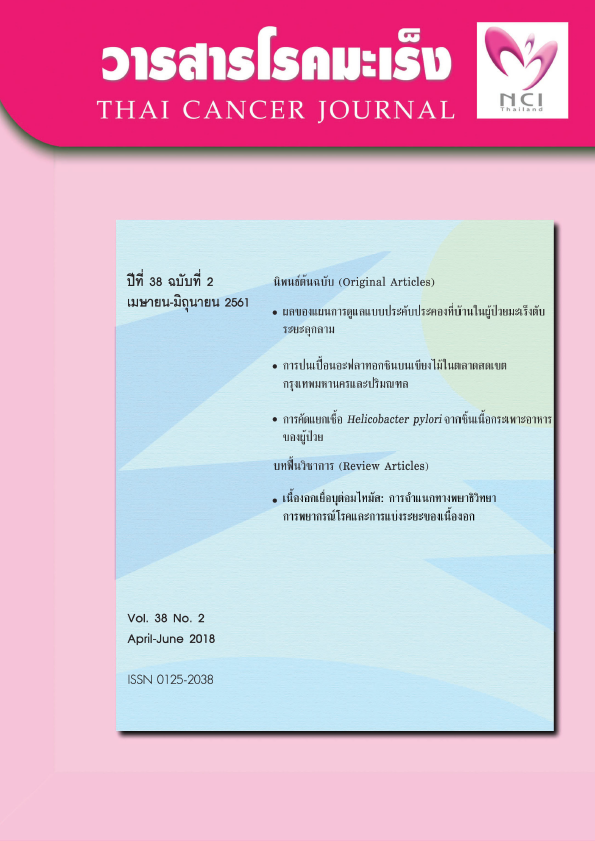Aflatoxin Contamination of Wooden Cutting Boards in Bangkok and Perimeter Markets
Keywords:
aflatoxins, contamination, wooden cutting boards, liver cancerAbstract
Aflatoxins are secondary metabolites produced by fungi which occur in cereals and forage. Aflatoxins are mainly produced by the molds of Aspergillus flavus and Aspergillus parasiticus. Prolonged exposure to aflatoxins has been linked to the development of liver cancer in humans, which is ranked as the leading cause of cancer death worldwide. However, a recent study found Aspergillus spp. contamination on wooden cutting boards in kitchens. A cross-sectional study was conducted to compare aflatoxin contamination and the washing of wooden cutting boards. The 44 wooden cutting-board samples were collected in the area of Bangkok and perimeter markets, during August-October 2016. Aflatoxin contamination of the samples was detected using immunochromatography test strips. The results showed that two of 44 samples (4.55%) were contaminated with aflatoxins. Both contaminated samples had been washed < 3 times per week. The findings showed that aflatoxins were found more often on wooden cutting boards washed < 3 times per week than those washed > 3 times per week (P=0.048). Therefore, butchers should frequently wash their wooden cutting boards before and after use to avoid aflatoxin contamination.
References
Ferlay J, Soerjomataram I, Dikshit R, Eser S, Mathers C, Rebelo M, et al. Cancer incidence and mortality worldwide: sources, methods and major patterns in GLOBOCAN 2012. Int J Cancer 2015;136:359-86.
สถาบันมะเร็งแห่งชาติ. สถิติโรคมะเร็งในประเทศไทย. เข้าถึงได้จาก: http://www.nci.go.th/th/ cancer_record/cancer_rec1.html. สืบค้นเมืÉอวันทีÉ 21 ธันวาคม 2560.
Zhu RX, Seto WK, Lai CL, Yuen MF. Epidemiology of hepatocellular carcinoma in the Asia-Pacific Region. Gut Liver 2016;10:332-9.
Janevska D, Chaloska-Ivanova V, Janevski V. Hepatocellular Carcinoma: Risk factors, diagnosis and treatment. Maced J Med Sci 2015;3:732-6.
หัชชา ศรีปลั่ง. วิเคราะห์คุณภาพข้อมูลมะเร็งและศึกษาสถานการณ์โรคมะเร็งและความสัมพันธ์กับแนวโน้มและการกระจายของปัจจัยเสี่ยงจากแหล่งข้อมูลต่าง ๆ. สำนักงานกองทุนสนับสนุนการสร้างเสริมสุขภาพ. เข้าถึงได้จาก: http://kb.hsri.or.th/dspace/handle/11228/3006?show=full. สืบค้นเมืÉอวันทีÉ 11 ธันวาคม 2560.
Ramesh J, Sarathchandra G, Sureshkumar V. Survey of market samples of food grains and grain flour for Aflatoxin B1 contamination. Int J Curr Microbiol Appl Sci 2013;2:184-8.
Rahmianna AA, Yusnawan E. Monitoring of Aflatoxin contamination at market food chain in east Java. Available from: http://www.jebas.org/00300420082015/10.18006_2015.3(4).346.352.pdf. Accessed
November 25, 2017.
IARC Working Group on the Evaluation of Carcinogenic Risk to Humans. Chemical Agents and Related Occupations. Available from: https://www.ncbi.nlm.nih.gov/books/NBK304413/. Accessed November 18,
สำนักอาหาร สำนักงานคณะกรรมการอาหารและยา. กฏหมายอาหาร. เข้าถึงได้จาก: http://food.fda.moph.go.th/law/index.php. สืบค้นเมื่อวันที่ 10 มกราคม 2561.
Kew MC. Aflatoxins as a cause of hepatocellular carcinoma. J Gastrointestin Liver Dis 2013;22:305-10.
Kongseng S. Estimated risk of liver cancer due to Aflatoxin exposure from red curry paste consumption in Bangkok population. Mahidol University. Available from: http://mulinet11.li.mahidol.ac.th/thesis/
/cd414/4837756.pdf. Accessed November 28, 2017.
วันเพ็ญ รัศมีโสภาพร, เนตรนภิส หัสมินทร์ และ ทรงศักดิ์ ศรีอนุชาติ. การปนเปื้อนของอฟลาทอกซินในก๋วยเตี๋ยวพร้อมบริโภคในเขตกรุงเทพมหานคร. สถาบันวิจัยโภชนาการ มหาวิทยาลัยมหิดล. เข้าถึงได้จาก: http://elib.fda.moph.go.th/multim/html7/12219_2.htm. สืบค้นเมื่อวันที่ 28 พฤศจิกายน 2560.
Barker J, Naeeni M, Bloomfield SF. The effects of cleaning and disinfection in reducing Salmonella contamination in a laboratory model kitchen. J Appl Microbiol 2003;95:1351-60.
Alwakeel SS. Bacterial and Aspergillus spp. Contamination of domestic kitchens in Riyadh, Saudi Arabia. Saudi J Biol Sci 2007;14:1-6.
Orogu JO, Akpobire D. Isolation and characterization of microorganisms in kitchen cutting board. Indo Am J P Sci 2017;4:2543-7.
Lee S-Y, Kim S-Y, Lee D, Hong Y-J, Bae Y-M, Choi N-Y, et al. Comparison of Sanitizing Methods for Reduction of Attached Microorganisms on Various Kitchen Cutting Boards. J Korean Soc Appl Biol Chem 2011;54:926-32.
Gehrig M, Schnell G, Zürcher E and Kucera L J. Hygienic aspects of wood and polyethylene cutting boards regarding food contaminations. A comparison. Available from: http://www.cabdirect.org/
cabdirect/abstract/20003036717. Accessed November 18, 2017.
สำนักสารนิเทศ กระทรวงสาธารณสุข. แนะวิธีเลี่ยงอาหารปนเปื้อนอะฟลาทอกซินป้องกันพิษสะสม. เข้าถึงได้จาก: http://pr.moph.go.th/iprg/include/admin_hotnew/show_hotnew.php?idHot_new=84154. สืบค้นเเมื่อวันที่ 10 มกราคม 2561.
Misner S and Curtis C. Cutting boards (Plastic vs. Wood). Cooperative Extension, College of Agriculture & Life Sciences. The University of Arizona. Available from: https://extension.arizona.edu/pubs/
cutting-boards-plastic-versus-wood. Accessed January 18, 2018.
Snyder P. The Microbiology of cleaning and sanitizing. Hospitality Institute of Technology and Management. Available from: http://www.hi-tm.com/Documents/Cutboard.html. Accessed November 18, 2017.
De Jong AE, Verhoeff-Bakkenes L, Nauta MJ, de Jonge R. Cross-contamination in the kitchen: effect of hygiene measures. J Appl Microbiol 2008;105: 615-24.
Downloads
Published
Issue
Section
License
บทความทีตีพิมพ์ในวารสารโรคมะเร็งนี้ถือว่าเป็นลิขสิทธิ์ของมูลนิธิสถาบันมะเร็งแห่งชาติ และผลงานวิชาการหรือวิจัยของคณะผู้เขียน ไม่ใช่ความคิดเห็นของบรรณาธิการหรือผู้จัดทํา







